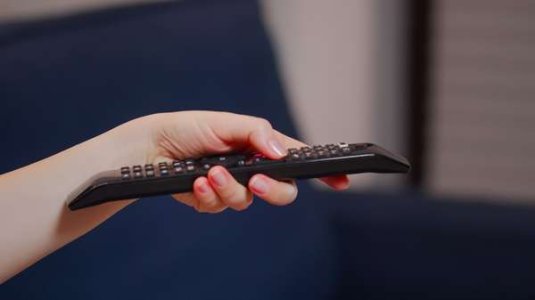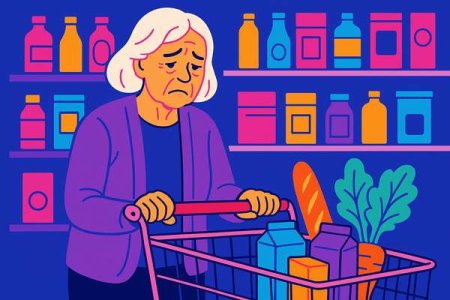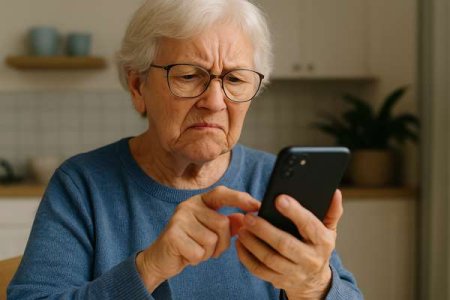Hard to Handle: How Everyday Products Are Failing Older Australians
An all-too-familiar sight for many seniors – a stubborn ring-pull can that refuses to budge. For older Australians, “packaging seems to be designed to keep you out,” as one frustrated consumer put it.
Ever used a pair of pliers to pry open a jar of jam? Squinted at microscopic print on a medicine bottle? If you’re an older Australian, chances are you have – and you’re not alone. Older Australians consistently rank independence and quality of life as their most valued priorities, yet everyday products are testing that independence.
From “impenetrable” packaging to gadgets that might as well require a pilot’s license, seniors are finding that so-called user-friendly products aren’t very friendly at all. A new survey of Australians aged 65+ confirms what many have long suspected: more than half of older consumers find products marketed to their age group difficult to use, and a majority feel their needs are simply overlooked by product designers. In fact, a whopping 93% of older Aussies said easy-to-use products are crucial for independent living, yet about 81% feel designers have missed the mark on basics like readable fonts, comfortable grips, and intuitive instructions.
It’s not just a few isolated complaints either – it’s a widespread grumble turning into a collective groan. “So many products, so many of them frustrating, impenetrable and hard to use,” says Jane Caro, a prominent Australian author and proud senior.
“Instructions are often impossible to read and indecipherable when you can. Packaging seems to be designed to keep you out. I can no longer undo jars, bottles, boxes, medicines, tubes and containers,” Caro lamented. Her words echo the experiences of countless older people who’ve felt defeated by a simple pill bottle or a tin of soup. It’s a frustrating irony – after decades of learning patience and resilience in life, seniors find themselves tripped up by everyday objects in their own kitchens and living rooms.
Let’s talk specifics. What kinds of products are causing grief for the grey-haired gang? A recent report by the Global Centre for Modern Ageing (GCMA) gathered hundreds of senior citizens’ pet peeves, and the list might sound familiar:
In short, many everyday items – from the TV in the lounge to the jar of Vegemite in the pantry – can feel like they’re working against older people. And unlike younger consumers who might grumble and move on, seniors often face a more consequential choice: figure out a workaround, or go without. Some give up on using a product altogether, sacrificing a bit of comfort or nutrition or enjoyment because it’s just not worth the struggle.
Others improvise tools and tricks (rubber jar openers, anyone?) or lean on family and friends for help. Yet, interestingly, nearly half of older Australians in the GCMA survey never ask for help or product modifications even when they’re dissatisfied. That stoic independence can mean suffering in silence – or in the case of stubborn packaging, suffering with a kitchen knife and a lot of muttering under one’s breath!
Older Australians are a tough bunch, but there’s a fine line between being resilient and being expected to “just put up with it.” Many seniors see the consistent lack of consideration in product design as a form of ageism – a silent message that their comfort and convenience don’t matter. “It’s ageism rearing its ugly, wrinkly head again. We ignore the old and think of them as deficient. We are not. We are just struggling to use poorly and insensitively designed products,” Jane Caro observed pointedly.
In other words, the problem isn’t Grandma or Grandpa losing their abilities – the problem is designers not using their abilities to make products workable for all.
Consider this: Australia is an ageing nation. As of 2021, about 16% of the population was 65 or older, and that share is projected to swell to around 21–23% by 2066. That’s nearly one in four Australians who will be seniors. Far from being a niche, older people are the market – a growing one. And they’re not exactly penny-pinching hermits either.
Many have money to spend (over 65s hold 55% of Australia’s wealth, by one estimate) and they have time to shop, yet, as Caro notes, they’re “rapidly losing the inclination” to buy when so many products are practically giving them the cold shoulder. It’s a cruel paradox: businesses are overlooking a cashed-up demographic that wants to buy things, if only those things were easier to handle.
When everyday products become daily obstacles, the impact on quality of life is real. Struggling to open food containers can lead to poorer nutrition (who wants to fight with a can of tomatoes for dinner, when toast is easier?). Fumbling with confusing gadgets can lead to isolation (if the TV or phone is too hard, some might simply use it less or not at all).
In extreme cases, bad design can even be dangerous – seniors have reported straining muscles, slipping, or injuring themselves while trying to force open packaging or operate ill-designed tools. One advocate from Arthritis Australia shares the story of a mother who literally couldn’t open a jam jar to make her kids a sandwich, calling it “a simple task but a huge barrier” that deeply affected her sense of autonomy. Think about that for a moment: something as ordinary as a jar lid can strip away a person’s ability to care for their family. When we talk about age-inclusive design, it’s not just about comfort – it’s about dignity.
In an era of smartphones, smart homes, and smart everything, one might hope technology would solve many of these problems. To some extent, it has. Modern tech has opened new doors for seniors: think of video calls with the grandkids, health apps that remind you to take your pills, or voice assistants like Siri and Alexa that can answer questions or turn off the lights without you getting up.
In fact, a recent survey found that eight in ten older Australians see technology as important for staying in touch with loved ones. Contrary to the stereotype, many seniors are surprisingly tech-savvy – 94% of Australians over 65 use mobile phones, and about three-quarters are on the internet enjoying emails, texts, and even social media. Today’s older generation is texting, Zooming, Googling, and generally adapting to the digital world with gusto.
But (and you knew a “but” was coming) – tech can be a double-edged sword. For every senior who loves their iPad, there’s another who finds modern devices needlessly convoluted. The GCMA study makes it clear that complicated technology is a top frustration for older users. It’s not for lack of trying; it’s often the design. Tiny icons, low-contrast text, finicky touchscreens, endless sub-menus – these can pose serious hurdles.
Imagine you’ve finally switched from a trusty flip phone to a new smartphone: you’re excited to join the WhatsApp family chat, but the darn phone keeps auto-dimming, notifications vanish into some menu abyss, and the “simple” act of answering a call is now a swipe (which you inevitably do the wrong way). It’s easy to see why some seniors throw up their hands and declare, “It’s too complicated!”
Digital products that seniors often use – like online banking apps, e-health portals, or even ATMs – can also miss the mark. Passwords, two-factor authentication, cryptic error messages – they offer security, yes, but sometimes at the expense of usability for someone who didn’t grow up in the digital era.
One senior might wonder: why does everything need a password that’s a mini-fortress? Why can’t websites have a simple, clutter-free “basic mode”? While many older Australians persevere and learn these tools, plenty will say they succeed in spite of the design, not because of it. The result is that some seniors limit their tech use to the essentials or rely on family for help with digital tasks. And as with physical products, a fair number suffer in silence rather than pick up the phone for help – pride and fear of “being a bother” are powerful deterrents, as the survey’s finding (43% don’t seek help) demonstrates.
The good news is that tech can be senior-friendly when done right. Bigger font settings, simplified “easy mode” interfaces, voice control features, and thorough customer support can make a huge difference. Many apps now have accessibility options that older users can benefit from – if they know how to enable them. And there are success stories: some seniors have mastered YouTube to fix a leaky tap or use Facebook Portal devices to chat with friends effortlessly.
The potential is there, but it often feels like tech companies design for the 25-year-old power user by default, with seniors as an afterthought. As one commentator put it, the industry often has a “disconnect between [its] belief that products are user-friendly and the actual usability challenges” older people face day to day. Bridging that digital divide in design is just as important as fixing the physical product issues.
So, what’s the solution? Do we resign ourselves to a world where opening a jar is a gym workout and using a phone is a brain teaser? Absolutely not. A growing chorus of voices – from consumer advocates to designers to seniors themselves – is calling for age-inclusive design in both physical and digital products.
And here’s the key: age-inclusive design isn’t only about older people; it’s about better products for everyone. When you make something easier for a 75-year-old with arthritis, you usually make it better for the 35-year-old juggling groceries and kids, or the 50-year-old with an injured wrist, or the 15-year-old who just wants things to be intuitive. As the design gurus like to say, “designing for the extreme users benefits all users.”
A classic example is the now-ubiquitous OXO Good Grips kitchen tools. Sam Farber invented a chunky, cushioned vegetable peeler because his wife (who had arthritis) couldn’t use the old metal ones – and it turned out people of all ages loved it. By focusing on folks with limited grip strength, OXO created utensils that everyone finds more comfortable. This is inclusive design in a nutshell: solve for the harder cases, and the solution will likely work better across the board.
There are encouraging signs that some companies are catching on. Arthritis Australia, for instance, runs an Accessible Design Division that tests and rates consumer packaging for ease of opening. They even award an “Easy to Open” certification for products that meet their standards (spoiler: not many do, but the list is slowly growing). One Australian food company, SPC, worked with Arthritis Australia to develop an easy-open snack cup after realizing how standard fruit cups were a torment to open. The resulting product features a textured grip, a larger tab, and clear instructions – simple tweaks that earned it a top accessibility rating and an international award.
It begs the question: if a fruit cup can be made senior-friendly without alienating other consumers (who wouldn’t want a cup that’s easier to open, after all?), why aren’t more companies following suit? Rose Herceg, president of a major marketing firm, noted that “55% of Australia’s wealth is held by those over 65” and urged businesses to ask, “What can [we] do for this market that [we weren’t] doing last week?”. In plain terms: design for seniors and you’ll be rewarded with loyal customers (and their families, who often choose products for them). It’s not charity – it’s just good business.
Inclusivity in design also means bringing seniors into the design process. The GCMA has pioneered “living labs” where older adults test products and give direct feedback to companies. It’s a form of co-design that treats seniors as knowledgeable consumers with specific needs – which they are – rather than as a problem to solve. This approach has led to innovations that might not sound exciting but make a real difference: things like better grips on garden tools, simpler interfaces on medical alert devices, or a kettle that’s easier to lift and pour.
Likewise, the Accessible Product Design Alliance (a coalition of health organizations) is advocating for more research and attention on everyday products that cause frustration, from medicine packaging to home appliances. Their message is clear: listen to the users who struggle the most, and design will improve for everyone. As one accessible design expert put it, “Packaging is something you have to open multiple times every day. If you’re in pain already and have to do tasks that require fine motor skills or hand strength, [difficult packaging] can make it impossible”. The same principle extends to all product categories – if you design assuming the user might have shaky hands, imperfect vision, and less endurance, you’re more likely to create something truly user-friendly (and not just for the elderly).
There’s also a cultural shift underway. Senior consumers today aren’t shy about sharing their experiences – and their frustrations – publicly. Social media groups, community forums, and advocacy campaigns (like Arthritis Australia’s annual “#WrapRank” highlighting the worst packaging offenders) are giving older Australians a platform to be heard. A recent viral story involved an man with Parkinson’s disease who posted a video struggling to open a pill bottle; within days a global community of designers prototyped an easier-to-use pill dispenser for him. The takeaway? When people speak up about design problems, solutions can be found – sometimes remarkably quickly.
At the end of the day, this isn’t just a rant about jar lids and phone screens. It’s a conversation about respect and inclusion. As Australia’s population ages, the way we design our world – from kitchen cupboards to websites – will determine whether older people can continue to live full, independent lives, or whether unnecessary obstacles will chip away at their freedom.
The momentum for change is growing, and this “often-forgotten community is beginning to be heard”. Companies are starting to realize that making life easier for seniors benefits everyone and can open up new markets. And older Australians, for their part, are raising their voices, demanding better and refusing to be an afterthought in design.
The question now is: will product manufacturers and tech developers truly listen and innovate for all ages, or will seniors keep having to jury-rig solutions for everyday items that should’ve been designed right in the first place? It’s a thought worth pondering – especially the next time you wrestle with a “child-proof” cap that’s also adult-proof, or squint at a user manual clearly printed for ants.
Isn’t it time we all expected (and demanded) products that work for everyone, young or old? What do you think?
READ MORE: Seniors Love Private Health Cover – But Can They Afford It?
The Daily Struggle is Real for Seniors
Ever used a pair of pliers to pry open a jar of jam? Squinted at microscopic print on a medicine bottle? If you’re an older Australian, chances are you have – and you’re not alone. Older Australians consistently rank independence and quality of life as their most valued priorities, yet everyday products are testing that independence.
From “impenetrable” packaging to gadgets that might as well require a pilot’s license, seniors are finding that so-called user-friendly products aren’t very friendly at all. A new survey of Australians aged 65+ confirms what many have long suspected: more than half of older consumers find products marketed to their age group difficult to use, and a majority feel their needs are simply overlooked by product designers. In fact, a whopping 93% of older Aussies said easy-to-use products are crucial for independent living, yet about 81% feel designers have missed the mark on basics like readable fonts, comfortable grips, and intuitive instructions.
It’s not just a few isolated complaints either – it’s a widespread grumble turning into a collective groan. “So many products, so many of them frustrating, impenetrable and hard to use,” says Jane Caro, a prominent Australian author and proud senior.
“Instructions are often impossible to read and indecipherable when you can. Packaging seems to be designed to keep you out. I can no longer undo jars, bottles, boxes, medicines, tubes and containers,” Caro lamented. Her words echo the experiences of countless older people who’ve felt defeated by a simple pill bottle or a tin of soup. It’s a frustrating irony – after decades of learning patience and resilience in life, seniors find themselves tripped up by everyday objects in their own kitchens and living rooms.
Everyday Products, Extraordinary Frustrations
Let’s talk specifics. What kinds of products are causing grief for the grey-haired gang? A recent report by the Global Centre for Modern Ageing (GCMA) gathered hundreds of senior citizens’ pet peeves, and the list might sound familiar:
- Gadget Overload: Modern electronic devices – from “smart” TVs to smartphones – often come with too many buttons, too many features, and manuals that read like rocket science. The result? Many older folks feel overwhelmed by technology that’s supposed to make life easier. Navigating endless menus with tiny icons or deciphering cryptic settings can turn a simple task (like changing the TV channel) into an ordeal.
- Mystifying Remotes & Interfaces: You’d think by now someone would have designed a simple TV remote for grandma. Yet, seniors report struggling with cluttered remote controls and touch-screen interfaces, finding it hard to navigate menus and functions on everything from microwaves to mobile phones.
- Microscopic Print: Is it just your eyesight, or are product labels getting smaller? Probably the latter. Fine print on labels, instructions, and packaging is a top complaint. When even the magnifying glass isn’t enough to read a medication dosage or the washing machine settings, something is wrong with the design. As one person quipped, instruction texts often seem “impossible to read and indecipherable when you can”.
- Packaging Nightmares: From pickle jars that won’t pop to those vacuum-sealed plastic packs that could resist a chainsaw, opening mechanisms are a major pain point. Jars, bottles, cans with ring-pulls, and those pesky pill blister packs often demand the grip strength of a bodybuilder or the ingenuity of a thief. Many seniors admit to stabbing packages with knives or scissors out of sheer desperation (and yes, we know that’s dangerous). In fact, Arthritis Australia warns that “hard-to-open packaging isn’t just inconvenient – it’s dangerous,” leading people to resort to unsafe hacks like transferring meds into non-childproof containers or even asking young kids for help.
- Heavy or Awkward Items: Ever try lifting a heavy vacuum cleaner up the stairs with arthritic knees, or pouring from a bulky kettle with unsteady hands? Weight and ergonomics matter. Older consumers report that big, heavy or awkwardly designed products – think large appliances, lawn equipment, or even oversize luggage – can be downright unusable without assistance. If it’s hard for a 30-year-old to lug, it’s a back injury waiting to happen for a 70-year-old.
- Safety & Stability Concerns: Designs that ignore age-related physical changes can put seniors at risk. A simple step stool with no handrail, a power tool with a stiff trigger, or a slick bathroom floor mat – such products can be accidents in the making. The survey highlighted worries about products like ladders, power tools and certain kitchen gadgets that don’t account for seniors’ reduced grip strength or balance. No one wants a trip to the ER because a product was “one-size-fits-all” for all ages.
In short, many everyday items – from the TV in the lounge to the jar of Vegemite in the pantry – can feel like they’re working against older people. And unlike younger consumers who might grumble and move on, seniors often face a more consequential choice: figure out a workaround, or go without. Some give up on using a product altogether, sacrificing a bit of comfort or nutrition or enjoyment because it’s just not worth the struggle.
Others improvise tools and tricks (rubber jar openers, anyone?) or lean on family and friends for help. Yet, interestingly, nearly half of older Australians in the GCMA survey never ask for help or product modifications even when they’re dissatisfied. That stoic independence can mean suffering in silence – or in the case of stubborn packaging, suffering with a kitchen knife and a lot of muttering under one’s breath!
When Design Feels Like Age Discrimination
Older Australians are a tough bunch, but there’s a fine line between being resilient and being expected to “just put up with it.” Many seniors see the consistent lack of consideration in product design as a form of ageism – a silent message that their comfort and convenience don’t matter. “It’s ageism rearing its ugly, wrinkly head again. We ignore the old and think of them as deficient. We are not. We are just struggling to use poorly and insensitively designed products,” Jane Caro observed pointedly.
In other words, the problem isn’t Grandma or Grandpa losing their abilities – the problem is designers not using their abilities to make products workable for all.
Consider this: Australia is an ageing nation. As of 2021, about 16% of the population was 65 or older, and that share is projected to swell to around 21–23% by 2066. That’s nearly one in four Australians who will be seniors. Far from being a niche, older people are the market – a growing one. And they’re not exactly penny-pinching hermits either.
Many have money to spend (over 65s hold 55% of Australia’s wealth, by one estimate) and they have time to shop, yet, as Caro notes, they’re “rapidly losing the inclination” to buy when so many products are practically giving them the cold shoulder. It’s a cruel paradox: businesses are overlooking a cashed-up demographic that wants to buy things, if only those things were easier to handle.
When everyday products become daily obstacles, the impact on quality of life is real. Struggling to open food containers can lead to poorer nutrition (who wants to fight with a can of tomatoes for dinner, when toast is easier?). Fumbling with confusing gadgets can lead to isolation (if the TV or phone is too hard, some might simply use it less or not at all).
In extreme cases, bad design can even be dangerous – seniors have reported straining muscles, slipping, or injuring themselves while trying to force open packaging or operate ill-designed tools. One advocate from Arthritis Australia shares the story of a mother who literally couldn’t open a jam jar to make her kids a sandwich, calling it “a simple task but a huge barrier” that deeply affected her sense of autonomy. Think about that for a moment: something as ordinary as a jar lid can strip away a person’s ability to care for their family. When we talk about age-inclusive design, it’s not just about comfort – it’s about dignity.
Tech to the Rescue? Not Always
Older Australians are increasingly tech-savvy, with 94% using mobile phones and half on social media – but that doesn’t mean today’s tech is always senior-friendly.In an era of smartphones, smart homes, and smart everything, one might hope technology would solve many of these problems. To some extent, it has. Modern tech has opened new doors for seniors: think of video calls with the grandkids, health apps that remind you to take your pills, or voice assistants like Siri and Alexa that can answer questions or turn off the lights without you getting up.
In fact, a recent survey found that eight in ten older Australians see technology as important for staying in touch with loved ones. Contrary to the stereotype, many seniors are surprisingly tech-savvy – 94% of Australians over 65 use mobile phones, and about three-quarters are on the internet enjoying emails, texts, and even social media. Today’s older generation is texting, Zooming, Googling, and generally adapting to the digital world with gusto.
But (and you knew a “but” was coming) – tech can be a double-edged sword. For every senior who loves their iPad, there’s another who finds modern devices needlessly convoluted. The GCMA study makes it clear that complicated technology is a top frustration for older users. It’s not for lack of trying; it’s often the design. Tiny icons, low-contrast text, finicky touchscreens, endless sub-menus – these can pose serious hurdles.
Imagine you’ve finally switched from a trusty flip phone to a new smartphone: you’re excited to join the WhatsApp family chat, but the darn phone keeps auto-dimming, notifications vanish into some menu abyss, and the “simple” act of answering a call is now a swipe (which you inevitably do the wrong way). It’s easy to see why some seniors throw up their hands and declare, “It’s too complicated!”
Digital products that seniors often use – like online banking apps, e-health portals, or even ATMs – can also miss the mark. Passwords, two-factor authentication, cryptic error messages – they offer security, yes, but sometimes at the expense of usability for someone who didn’t grow up in the digital era.
One senior might wonder: why does everything need a password that’s a mini-fortress? Why can’t websites have a simple, clutter-free “basic mode”? While many older Australians persevere and learn these tools, plenty will say they succeed in spite of the design, not because of it. The result is that some seniors limit their tech use to the essentials or rely on family for help with digital tasks. And as with physical products, a fair number suffer in silence rather than pick up the phone for help – pride and fear of “being a bother” are powerful deterrents, as the survey’s finding (43% don’t seek help) demonstrates.
The good news is that tech can be senior-friendly when done right. Bigger font settings, simplified “easy mode” interfaces, voice control features, and thorough customer support can make a huge difference. Many apps now have accessibility options that older users can benefit from – if they know how to enable them. And there are success stories: some seniors have mastered YouTube to fix a leaky tap or use Facebook Portal devices to chat with friends effortlessly.
The potential is there, but it often feels like tech companies design for the 25-year-old power user by default, with seniors as an afterthought. As one commentator put it, the industry often has a “disconnect between [its] belief that products are user-friendly and the actual usability challenges” older people face day to day. Bridging that digital divide in design is just as important as fixing the physical product issues.
Designing for All Ages – It’s Just Good Design
So, what’s the solution? Do we resign ourselves to a world where opening a jar is a gym workout and using a phone is a brain teaser? Absolutely not. A growing chorus of voices – from consumer advocates to designers to seniors themselves – is calling for age-inclusive design in both physical and digital products.
And here’s the key: age-inclusive design isn’t only about older people; it’s about better products for everyone. When you make something easier for a 75-year-old with arthritis, you usually make it better for the 35-year-old juggling groceries and kids, or the 50-year-old with an injured wrist, or the 15-year-old who just wants things to be intuitive. As the design gurus like to say, “designing for the extreme users benefits all users.”
A classic example is the now-ubiquitous OXO Good Grips kitchen tools. Sam Farber invented a chunky, cushioned vegetable peeler because his wife (who had arthritis) couldn’t use the old metal ones – and it turned out people of all ages loved it. By focusing on folks with limited grip strength, OXO created utensils that everyone finds more comfortable. This is inclusive design in a nutshell: solve for the harder cases, and the solution will likely work better across the board.
There are encouraging signs that some companies are catching on. Arthritis Australia, for instance, runs an Accessible Design Division that tests and rates consumer packaging for ease of opening. They even award an “Easy to Open” certification for products that meet their standards (spoiler: not many do, but the list is slowly growing). One Australian food company, SPC, worked with Arthritis Australia to develop an easy-open snack cup after realizing how standard fruit cups were a torment to open. The resulting product features a textured grip, a larger tab, and clear instructions – simple tweaks that earned it a top accessibility rating and an international award.
It begs the question: if a fruit cup can be made senior-friendly without alienating other consumers (who wouldn’t want a cup that’s easier to open, after all?), why aren’t more companies following suit? Rose Herceg, president of a major marketing firm, noted that “55% of Australia’s wealth is held by those over 65” and urged businesses to ask, “What can [we] do for this market that [we weren’t] doing last week?”. In plain terms: design for seniors and you’ll be rewarded with loyal customers (and their families, who often choose products for them). It’s not charity – it’s just good business.
Inclusivity in design also means bringing seniors into the design process. The GCMA has pioneered “living labs” where older adults test products and give direct feedback to companies. It’s a form of co-design that treats seniors as knowledgeable consumers with specific needs – which they are – rather than as a problem to solve. This approach has led to innovations that might not sound exciting but make a real difference: things like better grips on garden tools, simpler interfaces on medical alert devices, or a kettle that’s easier to lift and pour.
Likewise, the Accessible Product Design Alliance (a coalition of health organizations) is advocating for more research and attention on everyday products that cause frustration, from medicine packaging to home appliances. Their message is clear: listen to the users who struggle the most, and design will improve for everyone. As one accessible design expert put it, “Packaging is something you have to open multiple times every day. If you’re in pain already and have to do tasks that require fine motor skills or hand strength, [difficult packaging] can make it impossible”. The same principle extends to all product categories – if you design assuming the user might have shaky hands, imperfect vision, and less endurance, you’re more likely to create something truly user-friendly (and not just for the elderly).
There’s also a cultural shift underway. Senior consumers today aren’t shy about sharing their experiences – and their frustrations – publicly. Social media groups, community forums, and advocacy campaigns (like Arthritis Australia’s annual “#WrapRank” highlighting the worst packaging offenders) are giving older Australians a platform to be heard. A recent viral story involved an man with Parkinson’s disease who posted a video struggling to open a pill bottle; within days a global community of designers prototyped an easier-to-use pill dispenser for him. The takeaway? When people speak up about design problems, solutions can be found – sometimes remarkably quickly.
Time for an Age-Friendly Future
At the end of the day, this isn’t just a rant about jar lids and phone screens. It’s a conversation about respect and inclusion. As Australia’s population ages, the way we design our world – from kitchen cupboards to websites – will determine whether older people can continue to live full, independent lives, or whether unnecessary obstacles will chip away at their freedom.
The momentum for change is growing, and this “often-forgotten community is beginning to be heard”. Companies are starting to realize that making life easier for seniors benefits everyone and can open up new markets. And older Australians, for their part, are raising their voices, demanding better and refusing to be an afterthought in design.
The question now is: will product manufacturers and tech developers truly listen and innovate for all ages, or will seniors keep having to jury-rig solutions for everyday items that should’ve been designed right in the first place? It’s a thought worth pondering – especially the next time you wrestle with a “child-proof” cap that’s also adult-proof, or squint at a user manual clearly printed for ants.
Isn’t it time we all expected (and demanded) products that work for everyone, young or old? What do you think?
READ MORE: Seniors Love Private Health Cover – But Can They Afford It?











